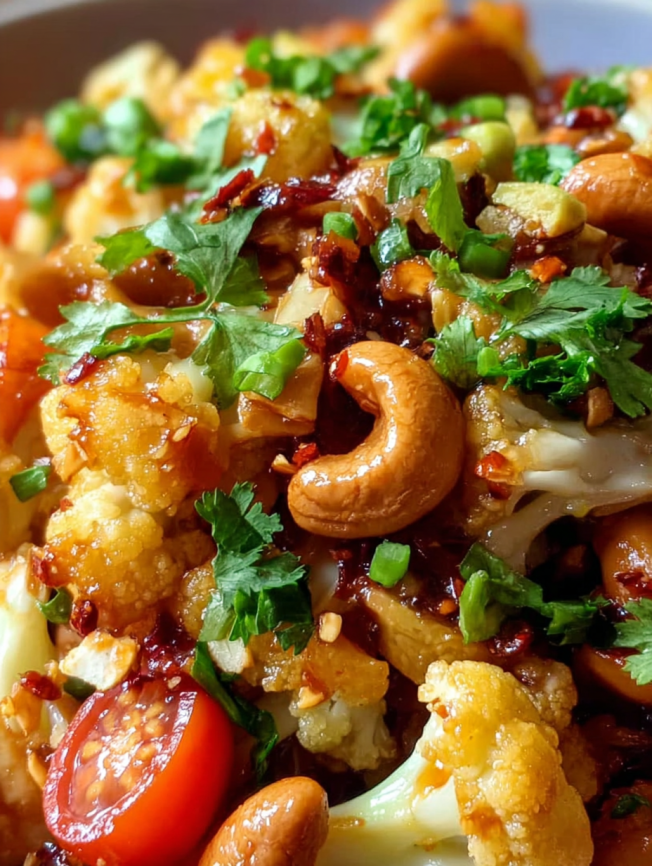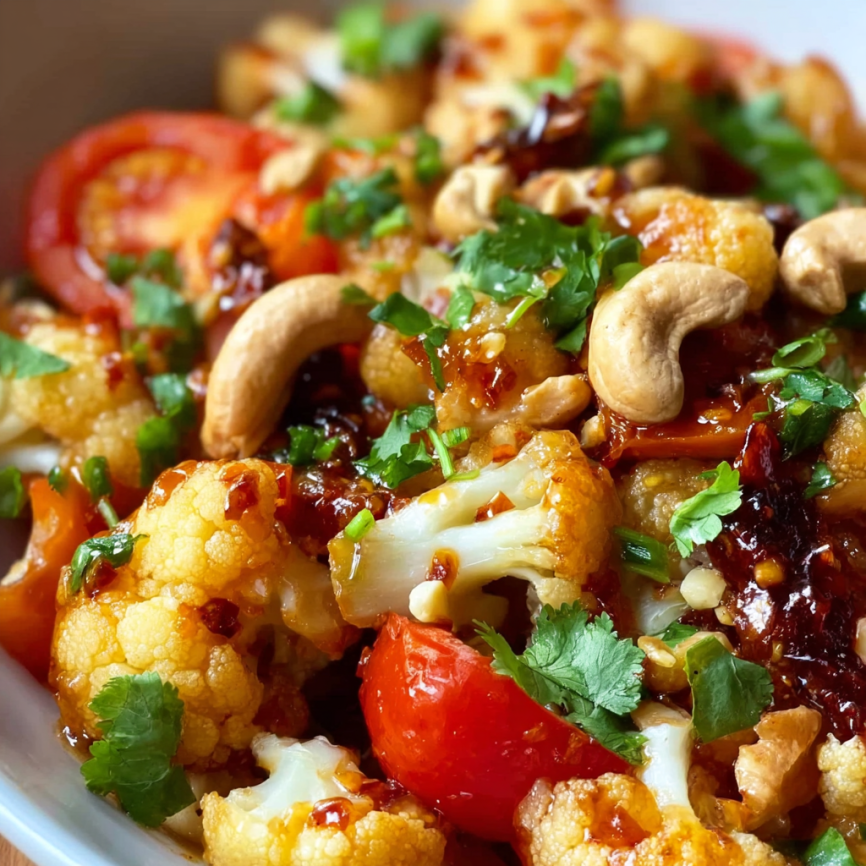The first time I made this Cashew Cauliflower Stir-Fry, I wasn’t expecting much – just another weeknight dinner to cross off my list. However, that first bite completely changed my perspective. The golden cauliflower, perfectly toasted cashews, and that incredible sauce created something magical in my kitchen. Now, it’s become my go-to recipe when I want something that feels both nourishing and indulgent, proving that plant-based cooking can be absolutely satisfying.
Why This Recipe Will Become Your New Favorite
Flavor Complexity Made Simple
This stir-fry masterfully balances sweet, savory, and umami flavors without requiring a pantry full of exotic ingredients. The combination of soy sauce, rice vinegar, and maple syrup creates a sauce that’s both familiar and exciting. Meanwhile, the turmeric adds an earthy depth that elevates the entire dish beyond typical weeknight fare.
Texture Heaven in Every Bite
One of the most satisfying aspects of this dish is its incredible textural variety. The tender-crisp cauliflower provides substance, while the toasted cashews add that perfect crunch. Additionally, the silky sauce ties everything together, creating a eating experience that’s both comforting and sophisticated.
Nutritional Powerhouse
Don’t let the indulgent taste fool you – this dish is packed with nutrition. Cauliflower provides vitamin C, fiber, and antioxidants, while cashews contribute healthy fats, protein, and essential minerals. Furthermore, the turmeric offers anti-inflammatory benefits, making this a meal that nourishes your body while satisfying your taste buds.
Quick and Weeknight-Friendly
With just 35 minutes from start to finish, this recipe fits perfectly into busy schedules. Most of the ingredients are pantry staples, and the preparation is straightforward enough for even novice cooks to master.
Essential Ingredients for Perfect Results
The Star Players
- 1 medium head of cauliflower, cut into florets – Choose firm, white florets for best results
- 3/4 cup raw cashews – The key to that irresistible crunch and richness
- 2 tablespoons vegetable oil – Provides the cooking base
- 1 onion, finely chopped – Creates the aromatic foundation
Aromatic Essentials
- 3 cloves garlic, minced – Fresh garlic is non-negotiable here
- 1 tablespoon fresh ginger, grated – Brings warmth and complexity
- 2 green onions, sliced – Adds fresh color and mild onion flavor
- Fresh cilantro, for garnish – Optional but highly recommended
The Magic Sauce Components
- 1/4 cup soy sauce – The umami backbone of the dish
- 2 tablespoons rice vinegar – Provides essential acidity and brightness
- 1 tablespoon maple syrup or honey – Balances the saltiness with subtle sweetness
- 1/2 teaspoon ground turmeric – Creates that beautiful golden color
- 1/2 teaspoon smoked paprika – Adds depth and subtle smokiness
- 1/4 teaspoon red chili flakes – Optional heat level booster
Step-by-Step Cooking Instructions
Preparing the Foundation
Preheat your oven to 375°F (190°C) and spread the raw cashews on a baking sheet. Toast them for 8-10 minutes until they turn golden and become fragrant. This step is crucial – properly toasted cashews develop a rich, nutty flavor that raw ones simply can’t provide. Set them aside once done.
Building the Flavor Base
Heat vegetable oil in a large skillet or wok over medium heat. Add the finely chopped onion and sauté for 3-4 minutes until it becomes soft and translucent. The onion should smell sweet and aromatic when ready.
Next, add the minced garlic and grated ginger to the pan. Cook for exactly 1 minute, stirring constantly to prevent burning. This brief cooking time releases their essential oils without making them bitter.
Cooking the Cauliflower
Add the cauliflower florets to the skillet and stir thoroughly to coat them with the aromatic mixture. Cook for about 5 minutes, allowing the cauliflower to begin softening and developing some golden edges. Don’t rush this step – the slight caramelization adds incredible depth to the final dish.
Creating the Sauce Magic
While the cauliflower cooks, whisk together the soy sauce, rice vinegar, maple syrup, turmeric, smoked paprika, and chili flakes in a small bowl. This sauce should smell complex and inviting – the perfect balance of salty, sweet, and aromatic.
Pour the sauce over the cauliflower and stir to ensure every floret gets coated. The turmeric will begin to work its magic, turning everything a beautiful golden color.
The Final Simmer
Cover the skillet and reduce the heat to low. Allow everything to simmer for 10-12 minutes until the cauliflower becomes tender but still maintains some bite. You don’t want mushy vegetables – they should be easily pierced with a fork but still have structure.
Finishing Touches
Stir in the toasted cashews and sliced green onions during the last minute of cooking. Season with salt and pepper to taste, keeping in mind that soy sauce already provides significant saltiness.

Perfect Serving Suggestions
Classic Presentations
Serve this stir-fry hot over a bed of steamed jasmine rice or brown rice, which absorbs the delicious sauce beautifully. Quinoa also makes an excellent base, adding extra protein and a nutty flavor that complements the cashews perfectly.
Creative Serving Ideas
For a low-carb option, serve over cauliflower rice or zucchini noodles. You can also stuff the mixture into lettuce wraps for a fresh, light meal. Additionally, it works wonderfully as a filling for grain bowls or Buddha bowls.
Garnish Like a Pro
Fresh cilantro adds a bright, herbaceous note that cuts through the richness. A squeeze of fresh lime juice just before serving brightens all the flavors. For extra heat lovers, a sprinkle of sesame seeds or additional chili flakes makes excellent finishing touches.
Delicious Recipe Variations
Protein Additions
While this dish is satisfying on its own, you can easily add protein. Cubed tofu, tempeh, or edamame work wonderfully with the existing flavors. For non-vegetarians, cooked chicken or shrimp can be stirred in during the last few minutes.
Vegetable Variations
Feel free to add other vegetables based on what you have available. Bell peppers, snap peas, broccoli, or carrots all work beautifully. Just adjust cooking times accordingly – harder vegetables should be added with the cauliflower, while softer ones can go in during the last few minutes.
Sauce Modifications
For a Thai-inspired twist, substitute the soy sauce with tamari and add a tablespoon of peanut butter to the sauce mixture. Alternatively, coconut aminos can replace soy sauce for a completely soy-free version.
Make-Ahead and Storage Tips
Meal Prep Strategy
This stir-fry is excellent for meal prepping. Cook a large batch and divide it into containers with your choice of grain. The flavors actually improve after sitting for a day, making it perfect for preparing ahead of busy weeks.
Storage Guidelines
Store leftovers in the refrigerator for up to 4 days in airtight containers. The dish can also be frozen for up to 2 months, though the texture of the cashews may change slightly upon thawing.
Reheating Instructions
Reheat gently on the stovetop over medium heat, adding a splash of water or additional soy sauce if the mixture seems dry. Microwave reheating works too, but use 50% power to prevent overcooking the vegetables.
Important Notes for Success
Cashew Selection and Storage
Choose raw, unsalted cashews for the best results. Store them in an airtight container in a cool, dry place, and they’ll stay fresh for months. Toasting them just before use ensures maximum flavor and crunch.
Cauliflower Preparation Tips
Cut the cauliflower into uniform, bite-sized pieces to ensure even cooking. Don’t make them too small, as they’ll break down too much during cooking. Aim for pieces about 1-2 inches in size.
Heat Level Management
The dish is mild as written, but you can easily adjust the heat level. Start with less chili flakes and add more to taste, or include fresh sliced jalapeños with the garlic and ginger for extra kick.

Frequently Asked Questions
Can I use frozen cauliflower instead of fresh?
While fresh is preferred, frozen cauliflower can work in a pinch. Thaw it completely and pat dry before cooking. However, be aware that frozen cauliflower may become softer and won’t have quite the same texture as fresh.
What can I substitute for cashews if I have a nut allergy?
Sunflower seeds or pumpkin seeds (pepitas) make excellent alternatives. Toast them the same way you would the cashews. For a completely different approach, try cubed firm tofu for added protein and texture.
How do I prevent the cauliflower from getting mushy?
The key is not to overcook it. Start checking for doneness after 8 minutes of covered simmering. The cauliflower should be tender enough to pierce easily with a fork but still hold its shape.
Can I make this dish gluten-free?
Absolutely! Simply substitute the soy sauce with tamari or coconut aminos. Both provide similar umami flavor while being naturally gluten-free.
What’s the best way to store leftover toasted cashews?
If you toast extra cashews, store them in an airtight container at room temperature for up to a week. They make excellent snacks on their own or additions to salads and other dishes.
Can I double this recipe for a crowd?
Yes, this recipe doubles easily. Just make sure you have a large enough skillet or wok to accommodate all the vegetables. You may need to cook in batches if your pan isn’t big enough.
How do I know when the cashews are perfectly toasted?
They should turn a light golden brown and smell nutty and fragrant. Watch them carefully during the last few minutes as they can go from perfectly toasted to burnt quickly.
Prep Time: 10 minutes | Cooking Time: 25 minutes | Total Time: 35 minutes
Calories: 280 kcal per serving | Servings: 4 generous portions
This Cashew Cauliflower Stir-Fry proves that vegetarian cooking doesn’t mean sacrificing flavor or satisfaction. With its perfect balance of textures, bold yet approachable flavors, and impressive nutritional profile, it’s a recipe that will earn a permanent spot in your dinner rotation. Whether you’re cooking for committed plant-eaters or trying to sneak more vegetables into your family’s diet, this dish delivers on all fronts.

